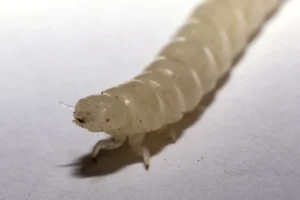Salamanders are fascinating little predators that mostly eat insects and other small invertebrates. If you have a pet salamander or you’re curious about what they eat, you might wonder whether mealworms are a good choice. Mealworms are popular feeder insects for many reptiles and amphibians, but are they safe and healthy for salamanders?
Yes, many salamanders can eat mealworms, but mealworms should only be fed occasionally and in moderation. Mealworms have hard exoskeletons that are harder to digest, so they are best offered as treats rather than a regular food source.
What Are Mealworms?
Mealworms are the larvae of the darkling beetle. They look like small, segmented worms with a tough outer shell.
Because they are easy to breed and widely available, mealworms are commonly sold as live food for pet reptiles, amphibians, and birds.

Mealworms are high in protein and fat, which makes them a rich source of energy. But their exoskeleton contains chitin, a tough fiber that can be difficult for some animals to digest.
Are Mealworms Good for Salamanders?
Many salamanders enjoy hunting and eating live mealworms. Mealworms move slowly, which makes them an appealing target for these stealthy predators.
The slow movement gives salamanders a good chance to catch them without too much effort.
However, because of the hard exoskeleton, mealworms should not be the main food source for salamanders.
Feeding too many mealworms can cause digestive problems or impaction. Impaction is a blockage in the gut caused by undigested food, which can be dangerous or even fatal if not treated.
You should use mealworms as part of a varied diet that includes softer prey items like crickets, earthworms, small flies, bloodworms, or other insects and larvae.
These softer foods are easier for salamanders to digest and provide a better balance of nutrients.
Feeding Tips for Mealworms
If you decide to feed mealworms to your salamander, there are some important tips to keep in mind.
First, feed small mealworms that match your salamander’s mouth size to avoid choking or injury. Young or small salamanders will need smaller mealworms.

Offer mealworms only occasionally, not every day. Feeding mealworms once or twice a week as treats is a good rule of thumb. This helps prevent digestive issues while keeping your salamander interested in its food.
Before feeding, you can lightly dust the mealworms with calcium or vitamin supplements. This helps ensure your salamander gets the nutrients it needs for healthy bones and overall wellness.
After feeding, remove any uneaten mealworms promptly. Live mealworms left in the enclosure can stress or even harm your salamander if they crawl on it or bite.
What Are the Risks?
Feeding too many mealworms comes with some risks. The hard exoskeletons are tough to break down and can lead to digestive issues or blockages, which might require veterinary care.
Mealworms are high in fat but low in some important vitamins and minerals. If mealworms become the main diet, this imbalance can cause nutritional problems over time.
Some salamanders might also have allergic reactions or irritation from certain feeder insects, including mealworms.
It’s always good to observe your salamander after feeding new foods to make sure it is eating well and not showing signs of distress.
Alternatives to Mealworms
While mealworms are convenient and easy to find, consider adding variety to your salamander’s diet.

- Crickets are a common staple feeder with a softer exoskeleton.
- Earthworms are highly nutritious and easy to digest for most salamander species.
- Fruit flies or small flies are excellent for small or juvenile salamanders that need tiny prey.
- Bloodworms or blackworms are especially good for aquatic or semi-aquatic salamanders.
Feeding a varied diet helps keep your salamander healthy, happy, and less likely to develop nutritional deficiencies.
Different prey items provide a broader range of vitamins, minerals, and textures that support natural feeding behavior.
Feeding Wild Salamanders
In the wild, salamanders eat whatever small insects, larvae, spiders, and worms they can find in their environment.
Mealworms are not native to most salamander habitats, but their natural diet includes similar prey that has soft bodies and lots of moisture.
If you’re observing salamanders in the wild, it’s best not to try to feed them human-provided insects. Wild salamanders get all the nutrition they need from their natural food sources.
Conclusion
Salamanders can eat mealworms, but these insects should only be offered occasionally and in moderation.
Mealworms have hard exoskeletons that can be difficult for salamanders to digest, so they’re best used as treats rather than staple food.
A varied diet of softer insects and worms will keep your salamander healthy and thriving.
If you keep salamanders as pets, provide a mix of live foods, dust them with supplements, and watch for any signs of digestive trouble after feeding mealworms.
By understanding the risks and benefits of mealworms and offering a balanced diet, you can help your salamander live a happy, healthy life.
Hi, my name is Ezra Mushala, i have been interested animals all my life. I am the main author and editor here at snakeinformer.com.

